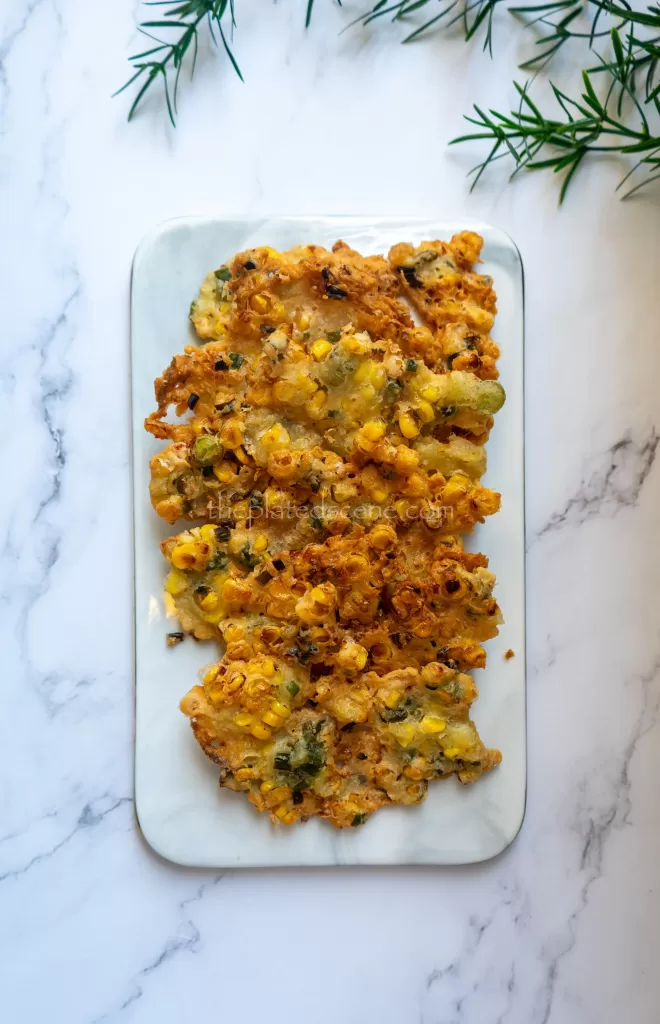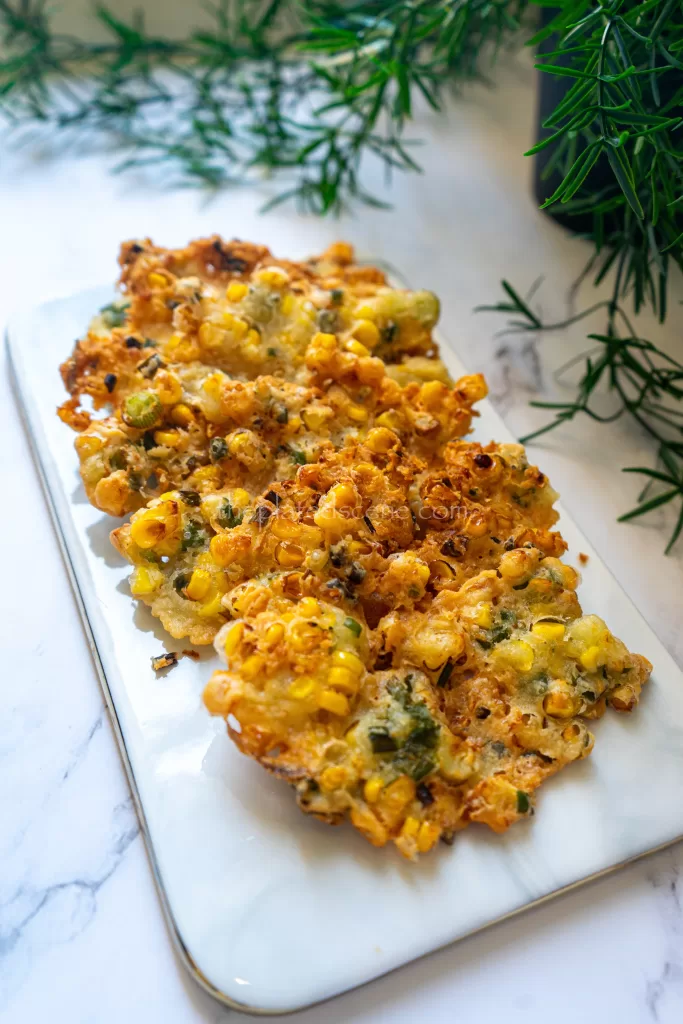Bakwan jagung, one of Indonesia’s most beloved snacks, is a crispy, savory-sweet delight that perfectly captures the essence of the nation’s culinary traditions. A staple in the wide variety of Indonesian gorengan (deep-fried snacks), bakwan jagung stands out for its golden crunch, sweet corn flavor, and versatility. Whether you enjoy it as a mid-afternoon treat or as part of a full meal, this deep-fried corn fritter delivers both taste and nostalgia.
For Indonesians, gorengan is more than just food—it’s a cultural experience. From bustling street food stalls to family kitchens, gorengan snacks like bakwan jagung are integral to daily life. These snacks represent Indonesia’s love for crispy textures and bold flavors, offering comfort and satisfaction in every bite.
Let’s explore the world of gorengan further and discover why bakwan jagung is one of its shining stars.
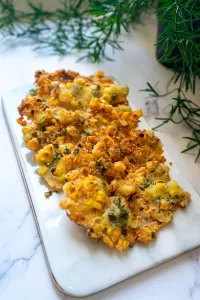
Table of Contents
What is Gorengan?
Gorengan refers to various deep-fried snacks that are widely popular in Indonesia. From savory fritters to sweet treats, gorengan encompasses diverse flavors and ingredients. Vendors selling gorengan are a common sight in Indonesia, with their stalls offering an array of crispy delights such as:
- Tempe goreng (fried tempeh): Thinly sliced tempeh coated in a spiced batter and fried until golden.
- Pisang goreng (fried banana): Sweet, ripe bananas coated in batter and fried to perfection.
- Bakwan jagung (corn fritters): This recipe focuses on fritters made with sweet corn, flour, and spices, fried until crispy.
These snacks are affordable, delicious, and deeply ingrained in Indonesia’s food culture. Whether enjoyed on the go or as part of a meal, gorengan offers a comforting crunch that resonates with everyone.
What is Bakwan and Bakwan Jagung?
While gorengan is the umbrella term for fried snacks, bakwan specifically refers to deep-fried fritters made with batter and various ingredients. Among the many types of bakwan, bakwan jagung is a standout favorite. Translating to “corn fritters,” bakwan jagung is made by mixing sweet corn kernels with flour, eggs, and seasonings, then frying spoonfuls of the batter until golden and crisp.
Other popular variations of bakwan include:
Despite the variety of bakwan, bakwan jagung holds a special place in Indonesian hearts thanks to its balance of sweet and savory and satisfying crunch.
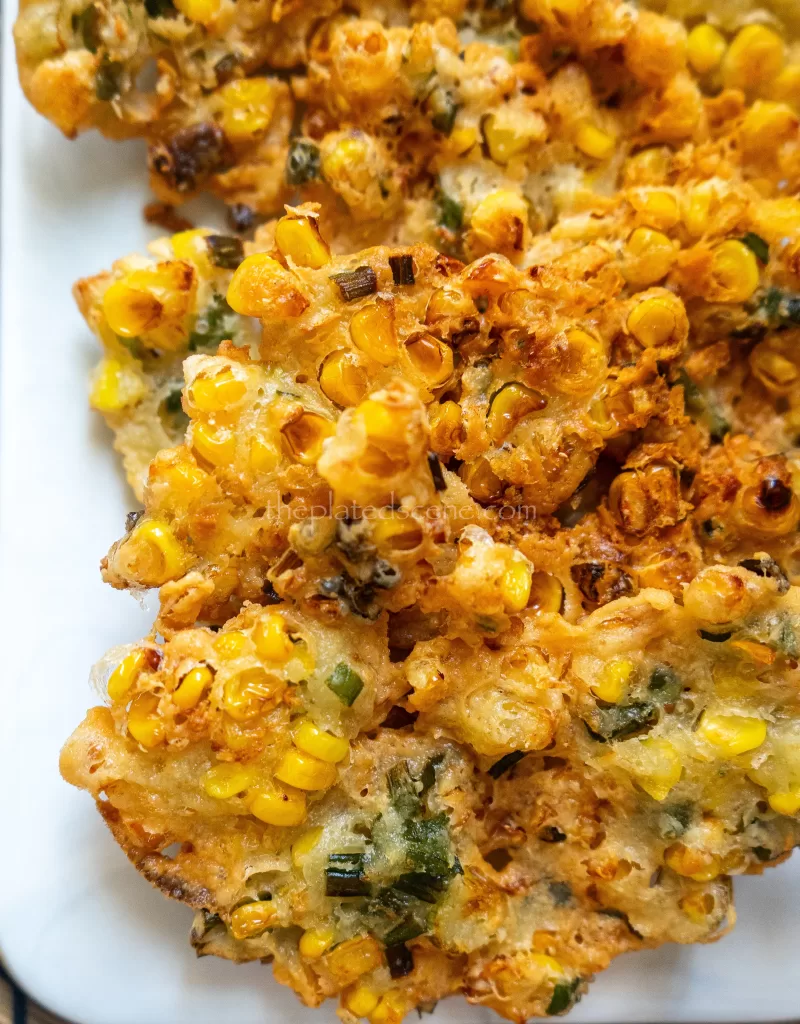
Why Indonesians Love Gorengan and Bakwan Jagung
The popularity of gorengan and bakwan jagung in Indonesia is deeply rooted in the country’s culinary traditions and lifestyle. Here’s why these snacks are universally loved:
- Crispy and Flavorful:
The crispy texture of gorengan, especially bakwan jagung, is irresistible. The natural sweetness of corn in bakwan jagung pairs beautifully with the savory spices, making it a well-rounded snack. - Affordable and Accessible:
Gorengan is widely available and inexpensive, making it a go-to snack for people from all walks of life. - Versatile:
Bakwan jagung can be enjoyed as a snack, dipped in sambal for extra heat, or served as a side dish with rice and soup. - Cultural Significance:
For many Indonesians, eating gorengan is a nostalgic experience that reminds them of home, family, and Indonesia’s vibrant street food culture.
But the joy of gorengan doesn’t stop with bakwan jagung. There are countless other options, each with unique taste and appeal. Here are two more must-try recipes to expand your gorengan experience:
- Tempe Tahu Bacem: Sweet and savory tempeh and tofu marinated in a rich broth of palm sugar and spices, then fried to crispy perfection.
- Fried Vegan Wontons: Crispy dumplings filled with a savory vegetable mix, served with a tangy tomato dipping sauce for a fresh twist.
The Allure of Bakwan Jagung
So, what makes bakwan jagung so beloved? Its perfect combination of flavors, textures, and versatility is the answer. Every bite of bakwan jagung offers a satisfying crunch from the crispy batter, a natural sweetness from the corn, and a hint of spice and umami from the seasonings. It’s a snack that feels indulgent yet comforting, reminding many Indonesians of home and cherished family meals.
Bakwan jagung is incredibly versatile, making it suitable for various occasions:
- As a Snack, bakwan jagung is a popular teatime treat enjoyed fresh from the frying pan. It is often paired with hot tea or coffee.
- As a Side Dish: Served alongside rice and soup, bakwan jagung adds a crispy element to a traditional Indonesian meal.
- As Party Food: These golden fritters are a hit at gatherings. They offer a finger-food option that’s easy to make in large batches.
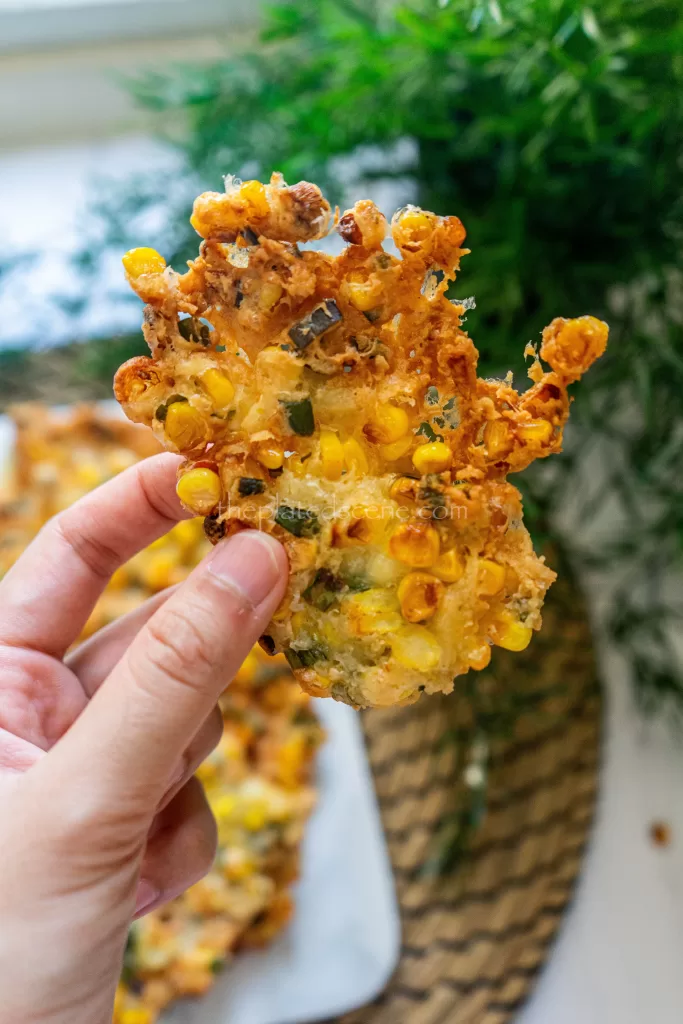
The Joy of Making Bakwan Jagung at Home
While bakwan jagung is a popular street food, it’s also easy to prepare at home. Making these fritters allows you to customize the seasoning and control the level of crispiness to suit your taste. The process involves mixing fresh corn kernels with a spiced batter, then deep-frying spoonfuls until golden.
Here are some tips for making the perfect bakwan jagung:
- Use Fresh Ingredients: Fresh corn delivers the best flavor and texture.
- Balance the Batter: The batter should be thick enough to hold the corn together but not so dense that it overpowers its natural sweetness.
- Fry in Small Batches: To ensure even cooking and maintain the oil’s temperature, fry the fritters in small batches.
You can try baking or air-frying bakwan jagung for a healthier twist, although the classic deep-fried version remains the gold standard for crunchiness.
What are the ingredients we need for Bakwan Jagung?
1. Obviously, Sweet Corn!!!!
It is super important to get sweet corn because you want to combine sweet and savory flavors in this dish. The butter and coconut milk will provide the savory. Since no sugar will be added to this dish, we will rely on corn as a source of sweetness. However, if it is hard to get sweet corn, the recipe will still work, and you will still get a crunchy snack; the taste will not be as great as using sweet corn!
If you buy corn on the cob like me, you must cut the corn kernel off the cob (pictured below). You can refer to my YouTube short to see how I do it. If I should describe that in words, here are the steps:
- Please remove all of the corn husk and silk and wash it thoroughly.
- Hold the corn from the stem perpendicular to the chopping board, and use a regular knife to scrape the kernel one straight line down at a time.
- Once your knife reaches the bottom of the corn, move to the following line. Repeat this process until you have scrapped all the kernels from the cob.
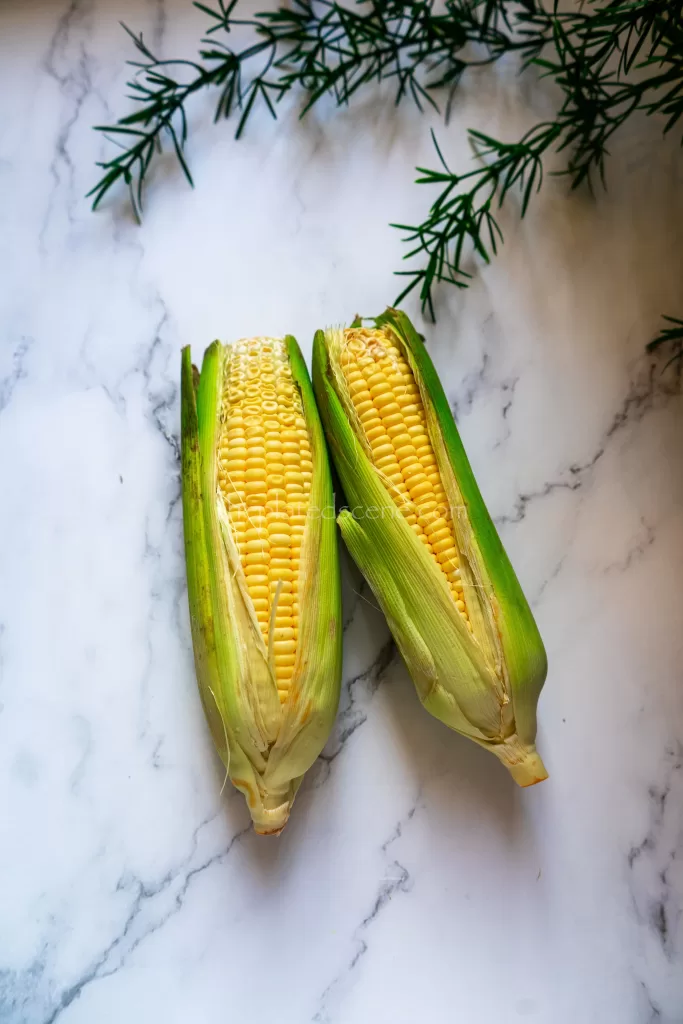
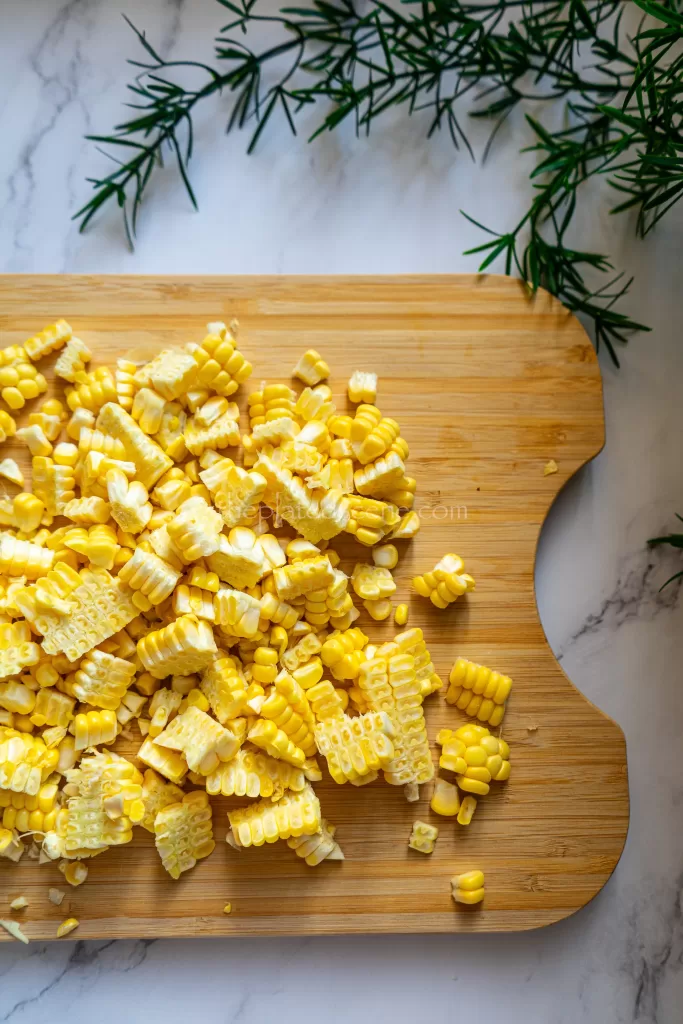
2. Spring Onion
Spring onion is optional, but adding this ingredient to bakwan will definitely elevate the flavor. It can help add a hint of onion flavor without being too overpowering. On top of that, adding this green onion to our bakwan will give it a pop of color, hence making it look more aesthetically pleasing.
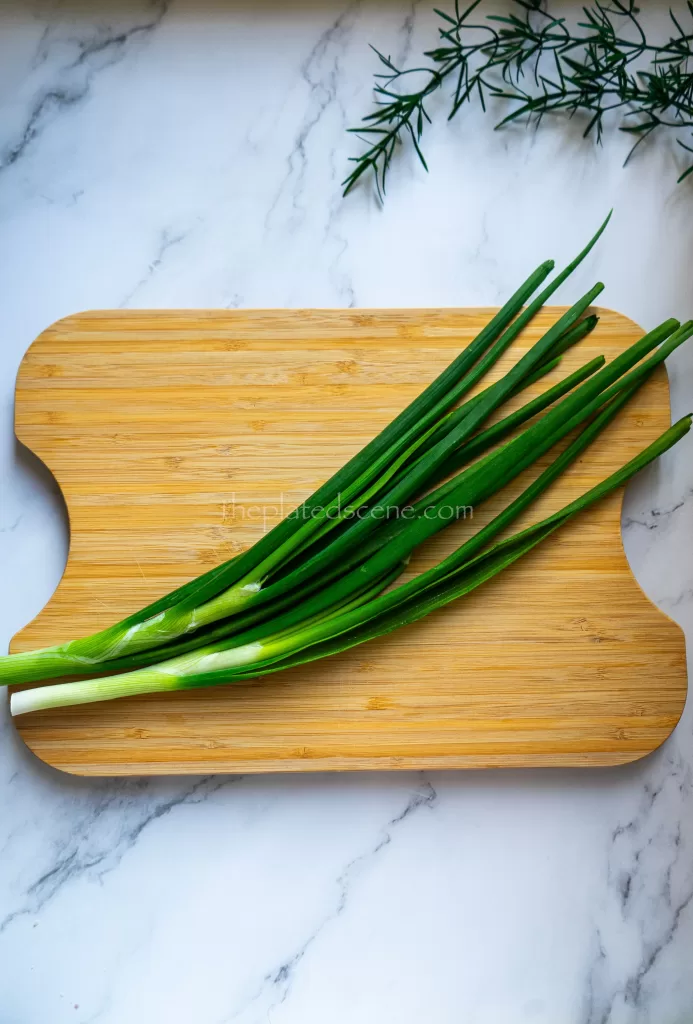
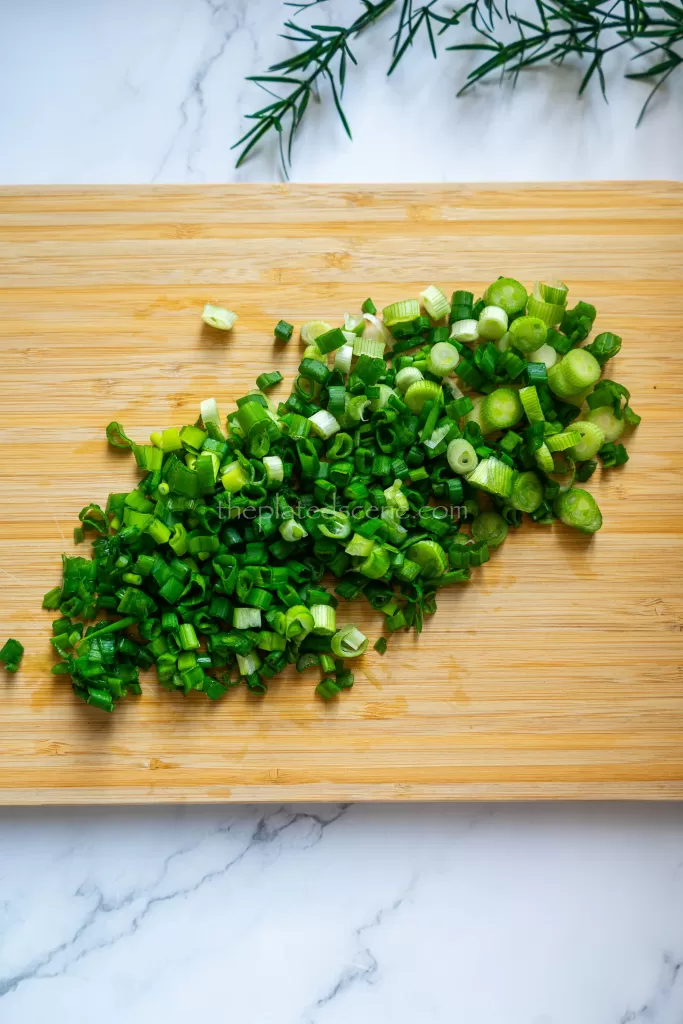
3. Flour and Seasoning
Flour
For this recipe, we are using two combinations of flour with a ratio of 7:3 (corn starch vs all-purpose flour)
- All-purpose flour: This flour is made of wheat. It contains gluten, which gives the inner part of bakwan jagung a chewier texture.
- Corn Starch: This flour does not contain gluten and tends to be lighter. We need this flour to crisp up the outer layer of our bakwan jagung!
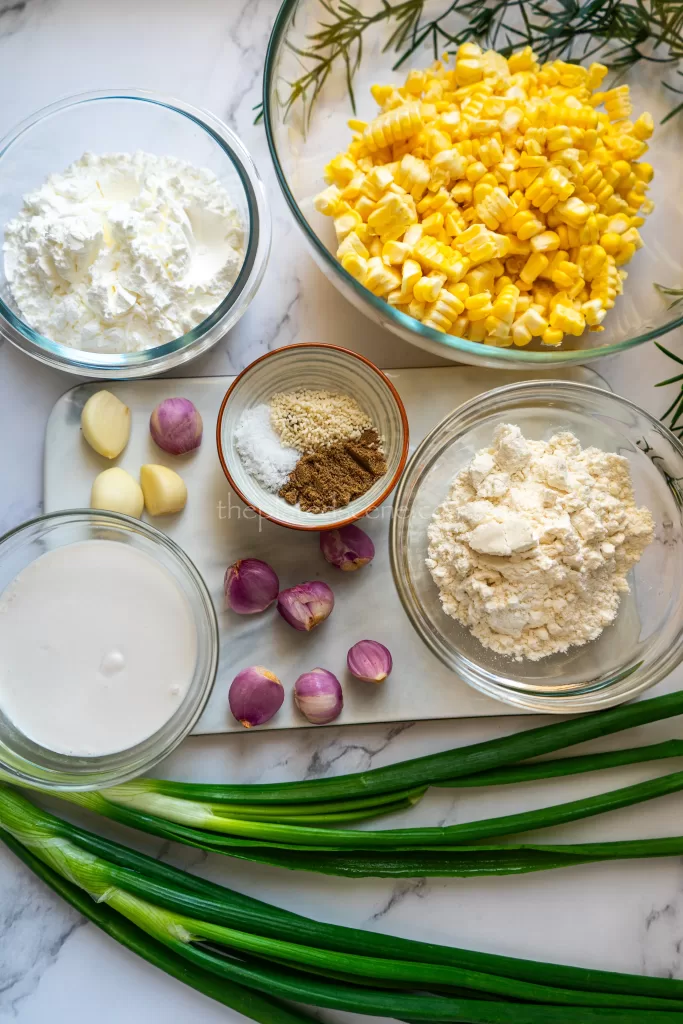
Seasoning
- Garlic and shallot: Shallot and garlic are staples in Indonesian recipes. You always need to have both in your kitchen. It’s pretty rare for Indonesian recipes to use one without the other. Garlic has a strong and pungent flavor and is often used in savory dishes to add flavor and depth. Shallots have a milder flavor than garlic, with a hint of sweetness.
- Mushroom Stock: This will give the bakwan its “umami” flavor. I’m using the Totole brand, which is famous in Indonesia. You can substitute it with vegetable stock.
- Coriander Seeds: I am using the powder version in this recipe because I don’t have a fresh one. If you have a fresh one, you can dry roast the fresh seeds to enhance the flavor, aroma, and pungency, but you don’t have to. Coriander seeds, in general, will add a mild citrusy hint with a slight curry flavor. If you don’t have coriander in your kitchen staples, try substituting it with cumin.
- Salt
Coconut Milk
Coconut milk is also an optional ingredient, similar to green onion, but it would be great if you could add it! It adds a rich, creamy texture to the bakwan, enhancing its overall mouthfeel. This creaminess helps balance the spices and flavors of the blended herbs. Yummy :).
Step by Step to Make Bakwan Jagung
1. Blend the Aromatics
Blend garlic and shallots with a small amount of water until smooth and no chunks are visible. If using coriander seeds, add them to the blender with the garlic and shallots. This aromatic blend forms the flavor base of the batter and ensures even seasoning throughout.
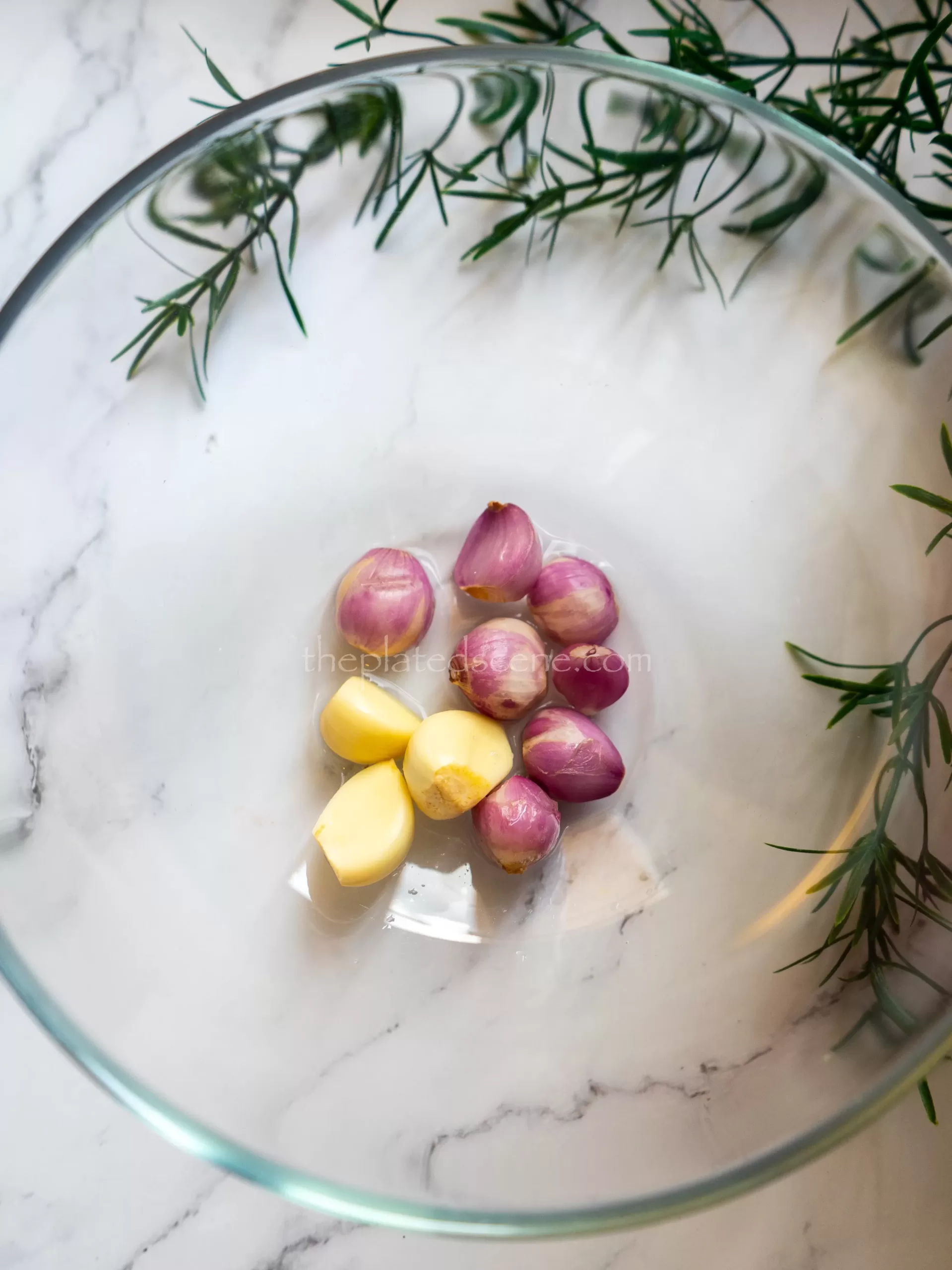
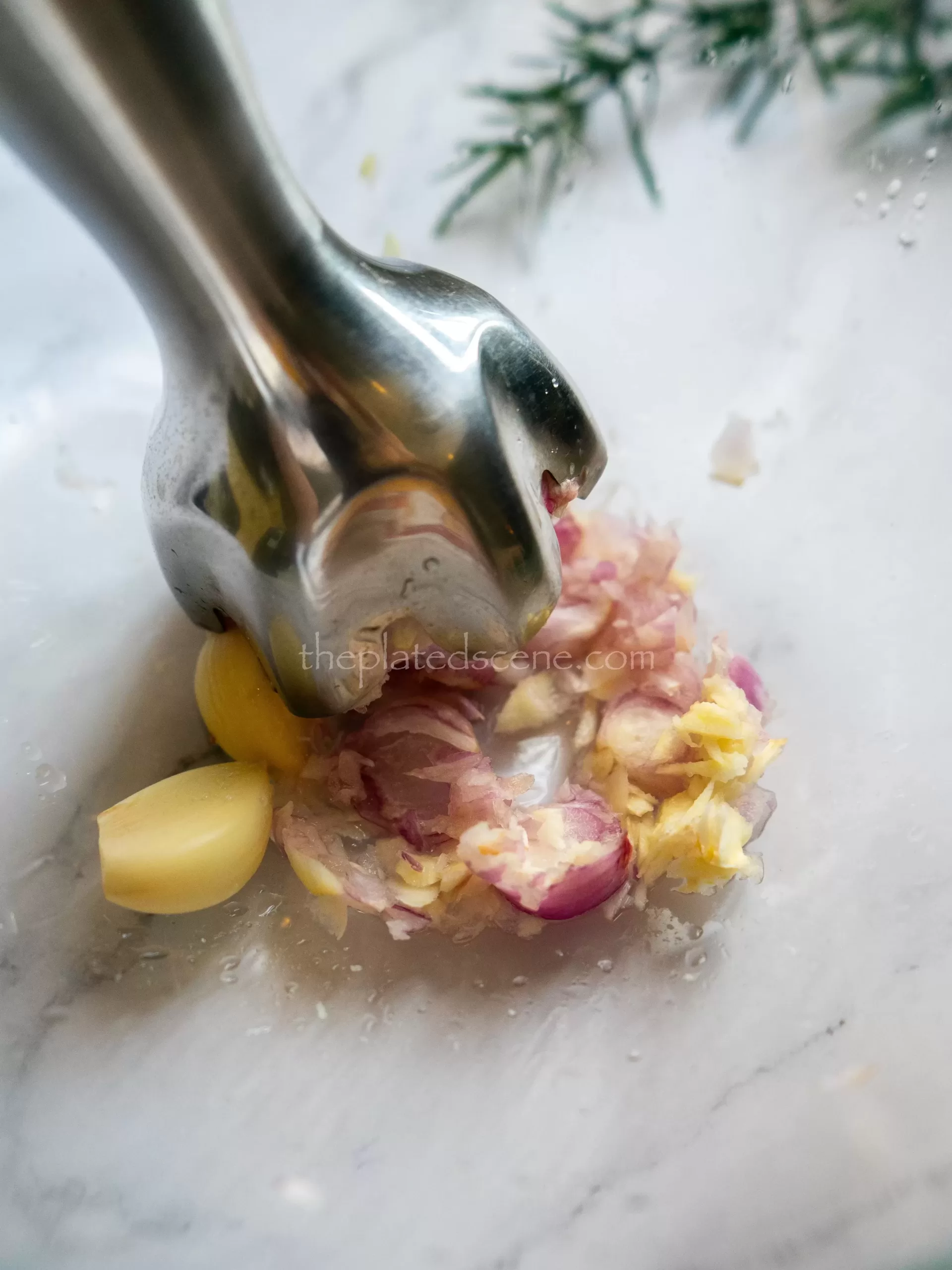
- Tools to Use: Any blender suitable for blending small ingredients will work. For this recipe, I’m using a Braun immersion blender with its primary blade attachment, which is convenient for small portions.
- Alternative Options: Don’t have an immersion blender? No problem! A regular blender works just as well—just scrape down the sides to ensure even blending. You can grind the ingredients using a mortar and pestle for a more traditional method. While it requires more effort, it allows you to control the texture for an authentic result.
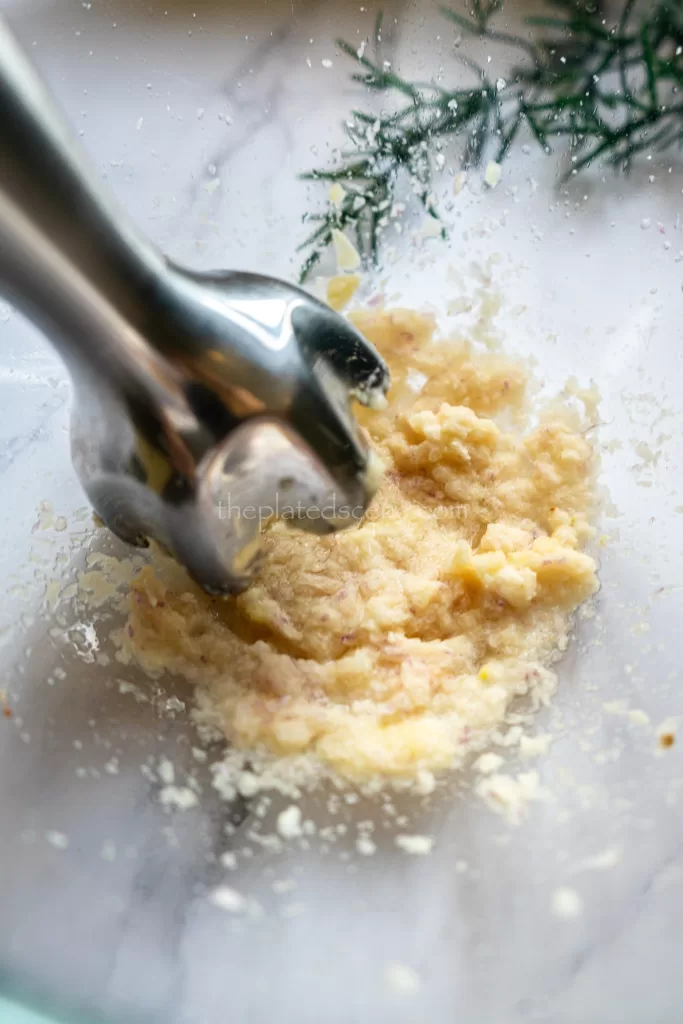
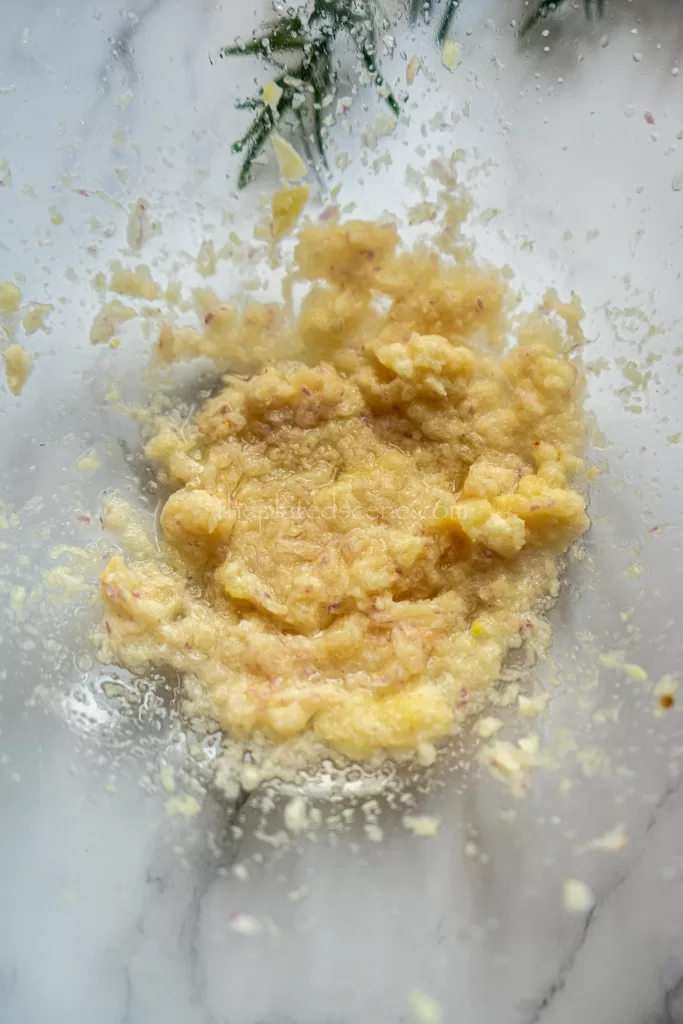
Pro Tip: If your blender struggles with small quantities, add a tiny amount of coconut milk instead of water to help it blend more smoothly and enhance the batter’s overall flavor.
2. Combine Ingredients and Seasonings
Transfer the blended aromatics into a mixing bowl. Add the remaining ingredients and seasonings to the bowl, including:
- Corn Kernels: Use fresh or canned sweet corn for the best flavor and texture.
- Spring Onions: Finely sliced to add color and a mild oniony taste.
- All-purpose flour and cornstarch act as binding agents and contribute to the crispiness.
- Seasonings: Add salt, mushroom stock powder (for umami), and coriander powder to enhance the flavor.
- Coconut Milk: Adds a subtle richness and helps bind the batter.
Gently mix everything with a spatula to ensure an even distribution of all ingredients.
Pro Tip: If you’re using canned corn, drain it thoroughly before mixing to prevent the batter from becoming too watery. To improve the results, pat the corn dry with a paper towel.
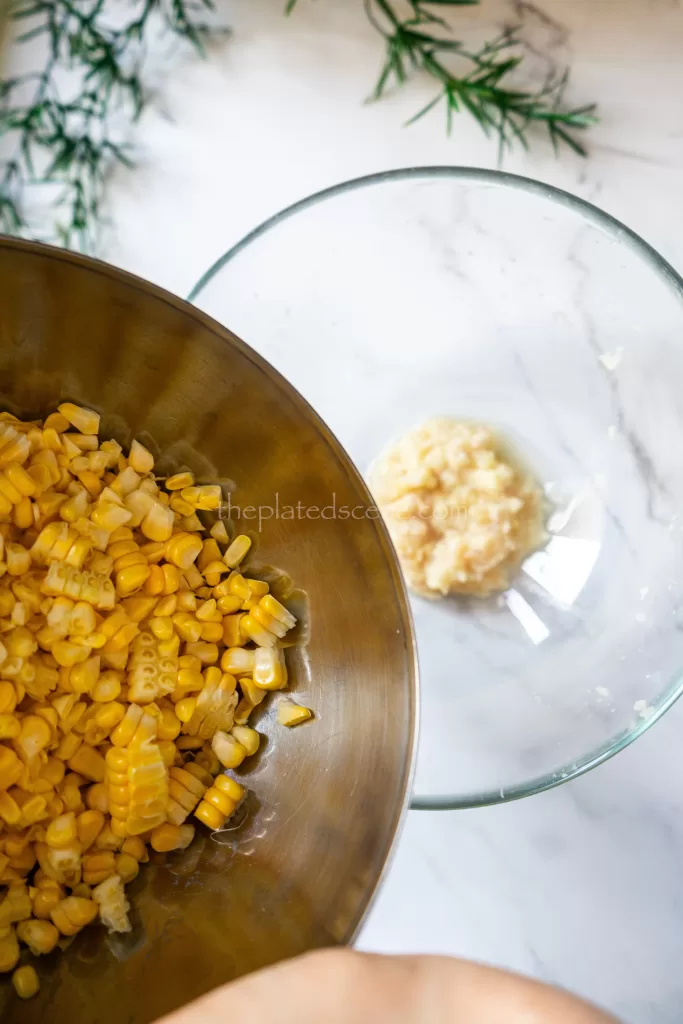
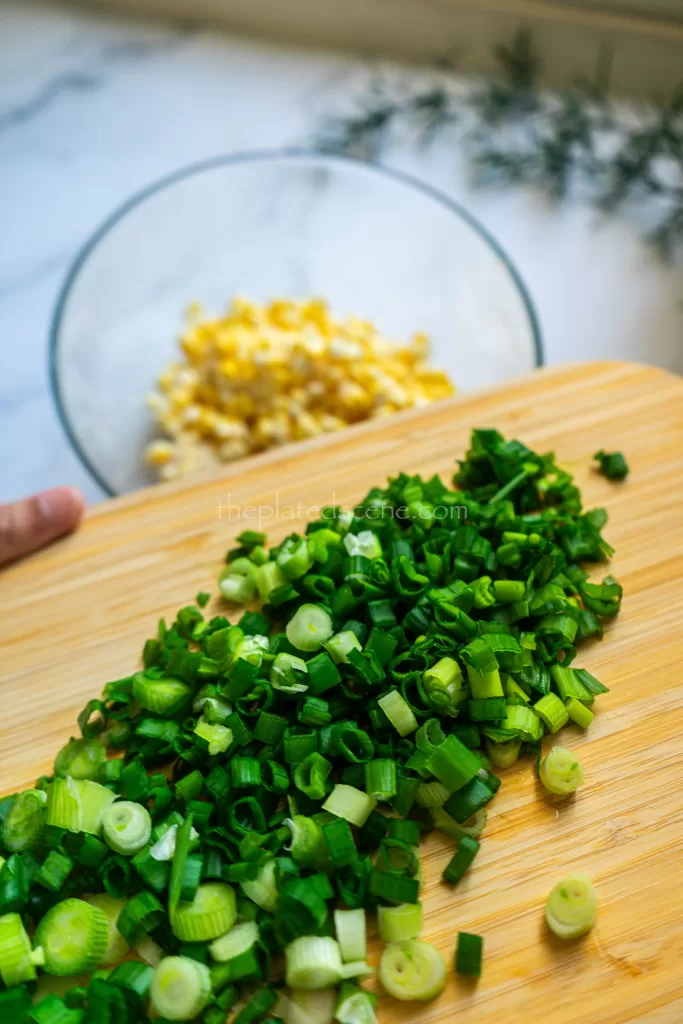
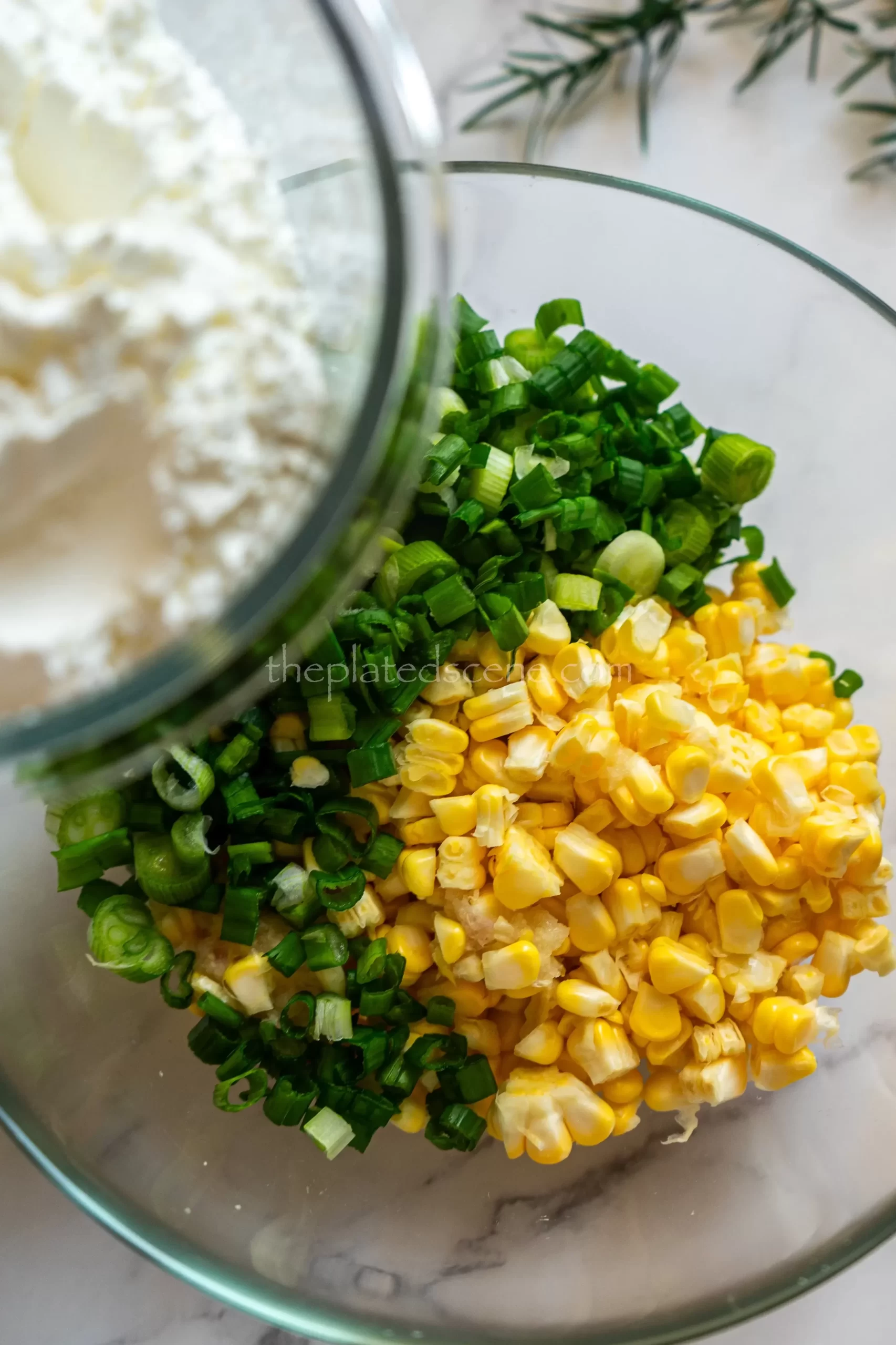
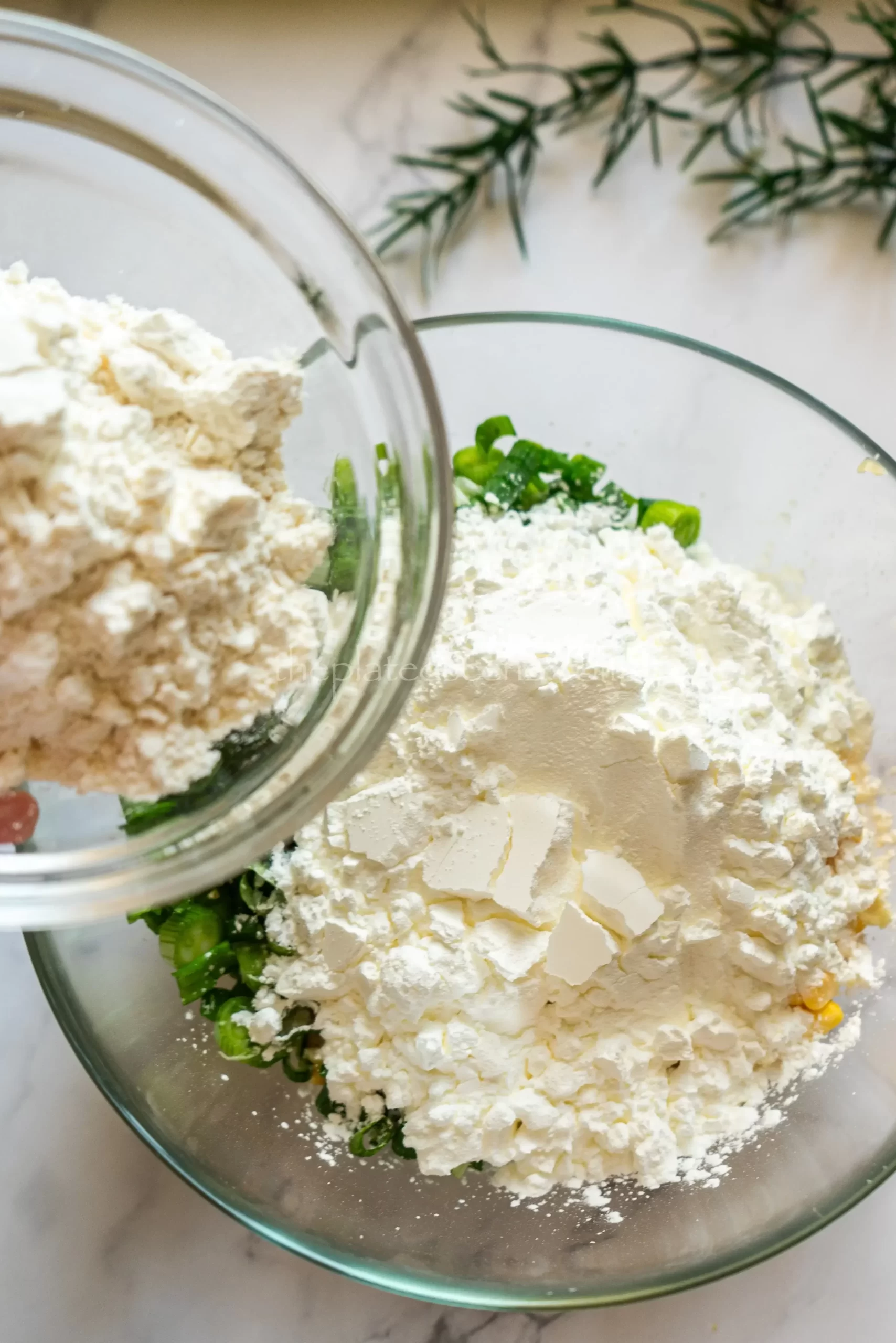
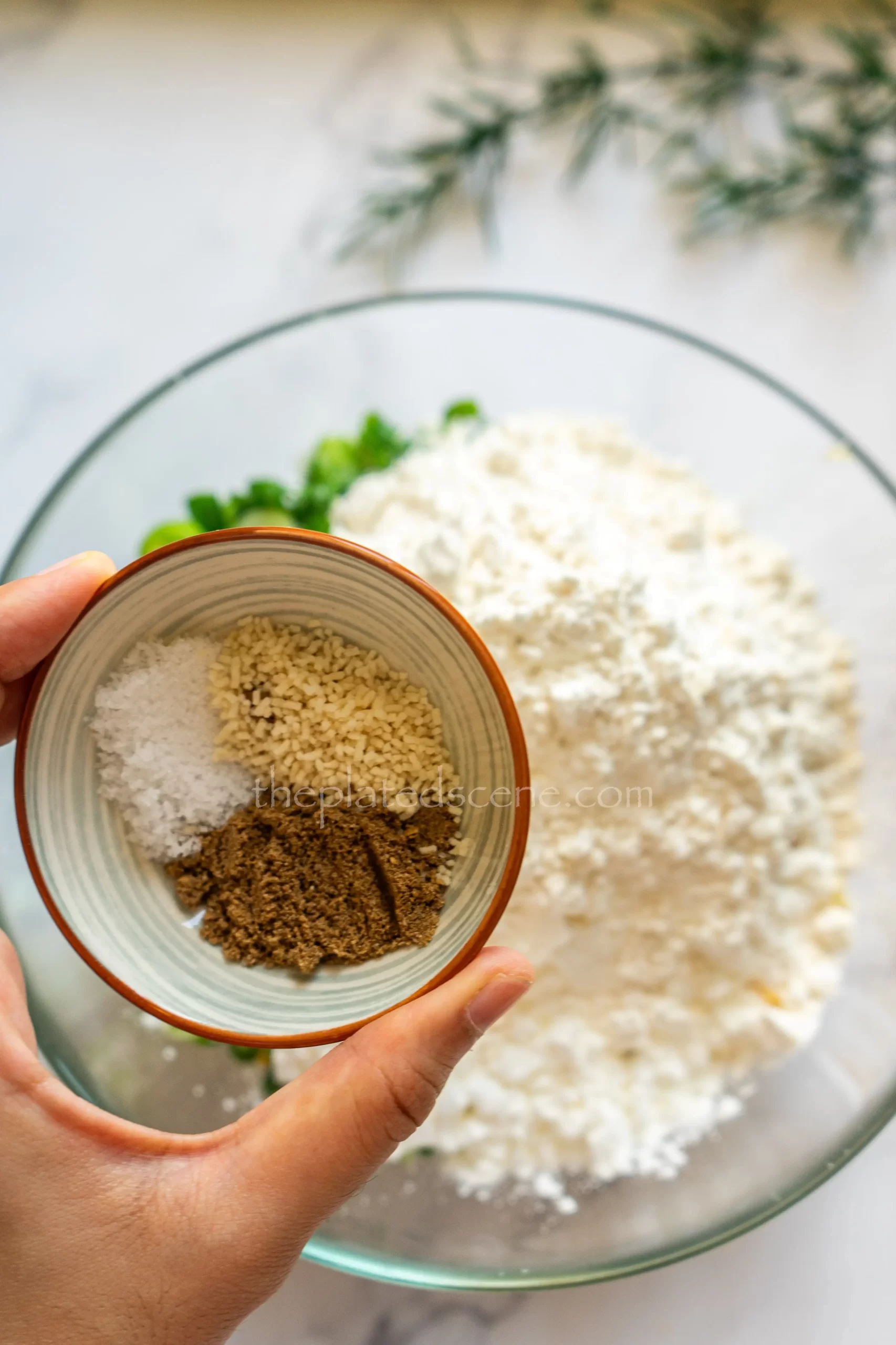
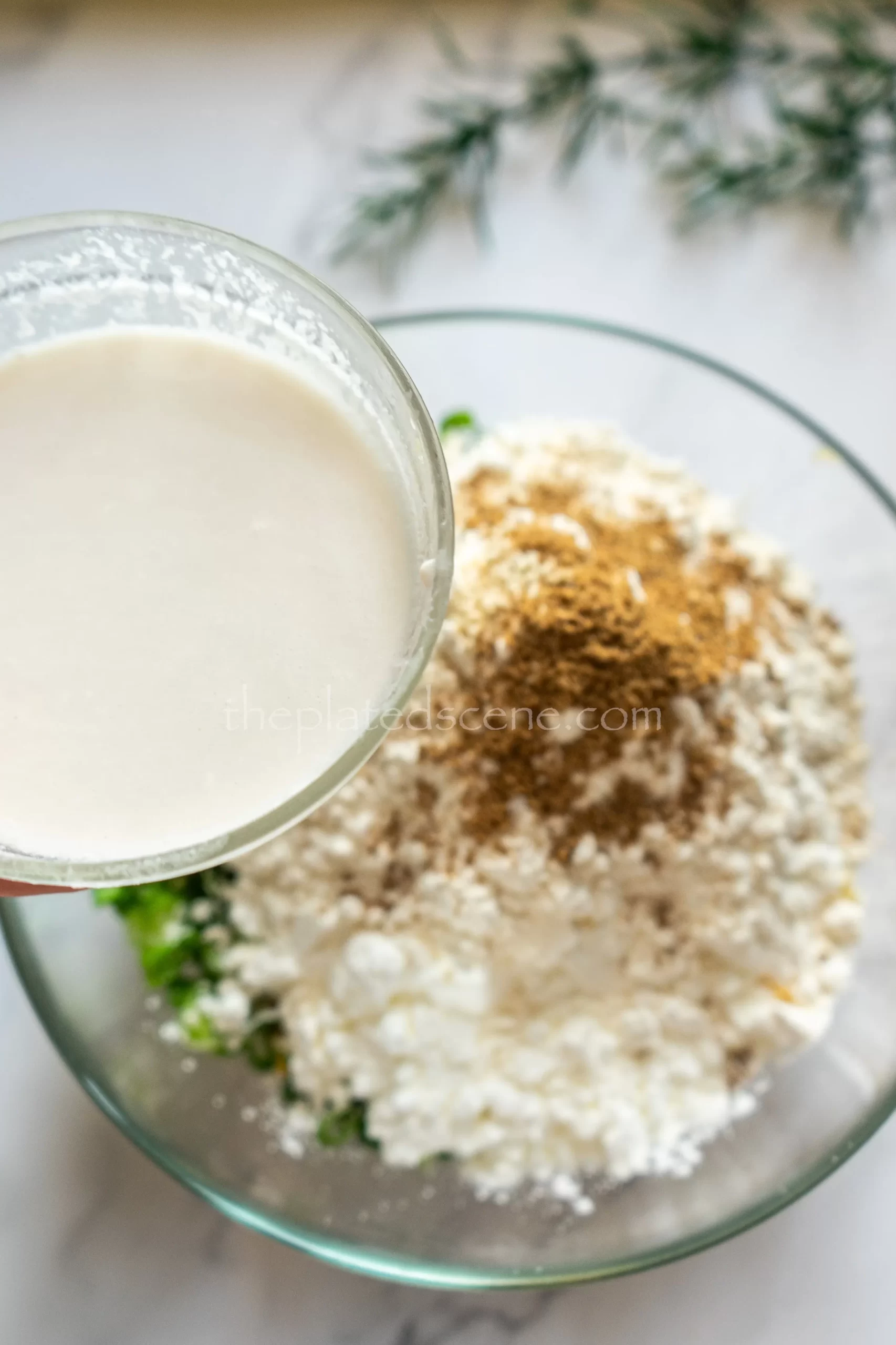
3. Adjust the Batter Consistency
Gradually add 50 ml of water to the mixture, mixing gently with a spatula until it forms a thick batter. The batter should coat the ingredients well without being runny. Avoid overmixing, as it can affect the texture of the fritters.
Pro Tip: Add a tablespoon of rice flour or tapioca flour to the batter if you want an extra crispy texture.
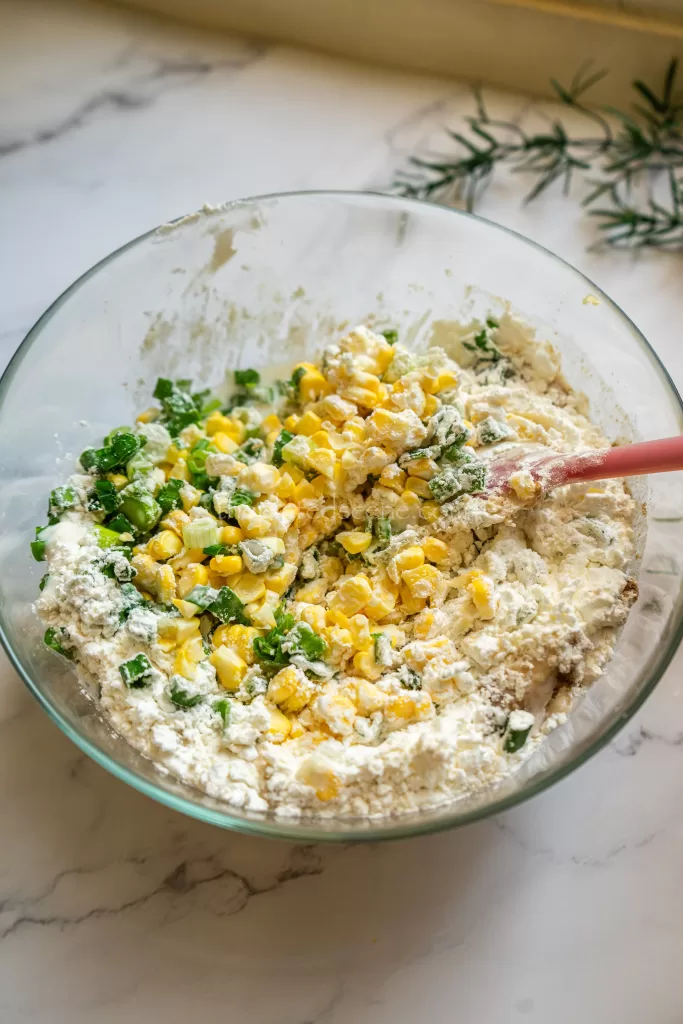
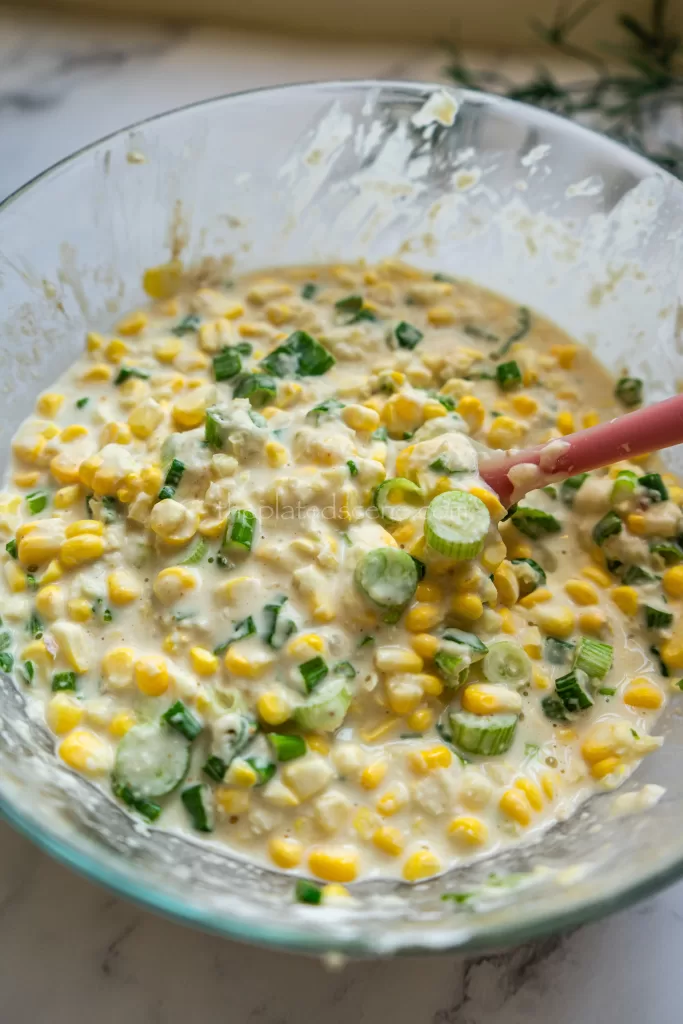
4. Heat the Oil and Fry
Heat oil in a frying pan over medium heat, ensuring the oil depth is around 1–2 cm—sufficient for shallow frying. I am using an induction stove set to 160°C (320°F), but you can adjust the heat based on your stove.
- Portion the Batter: Use a spoon or small ladle to drop portions of the batter into the hot oil. For a crispy texture, spread the batter slightly to create a wide surface area with a thin depth.
- Frying Tips: Fry several portions at a time, but avoid overcrowding the pan, as this can lower the oil temperature and make the fritters greasy.
Fry each side for about 2–3 minutes or until golden brown. Flip the fritters with a spatula or tongs to ensure even cooking. The cooking time may vary depending on the batter’s thickness and heat settings.
Pro Tip: Test the oil temperature by dropping a small dollop of batter into the pan. The oil is ready if it sizzles immediately and floats to the surface. The oil isn’t hot enough if it sinks or doesn’t bubble.
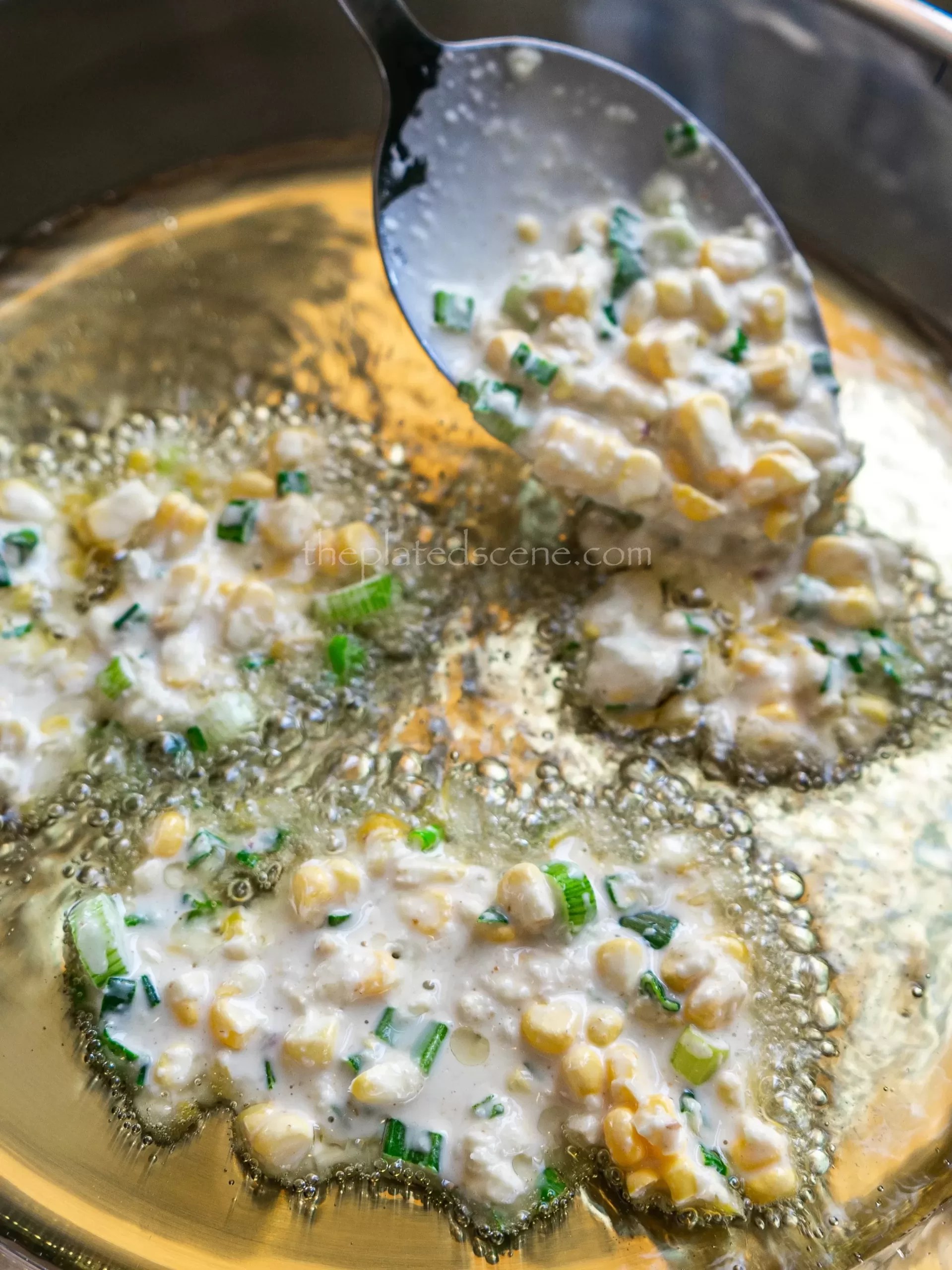
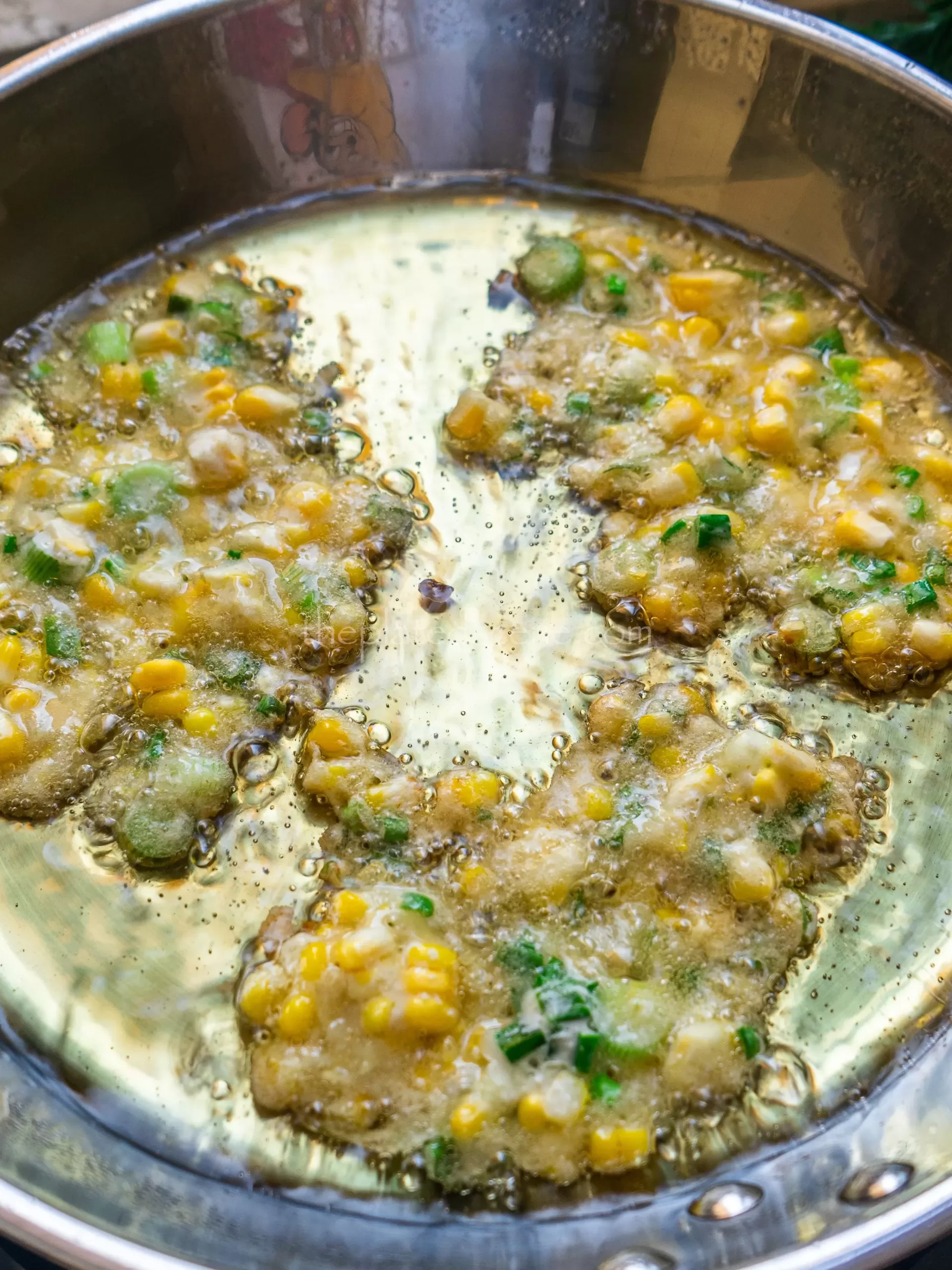
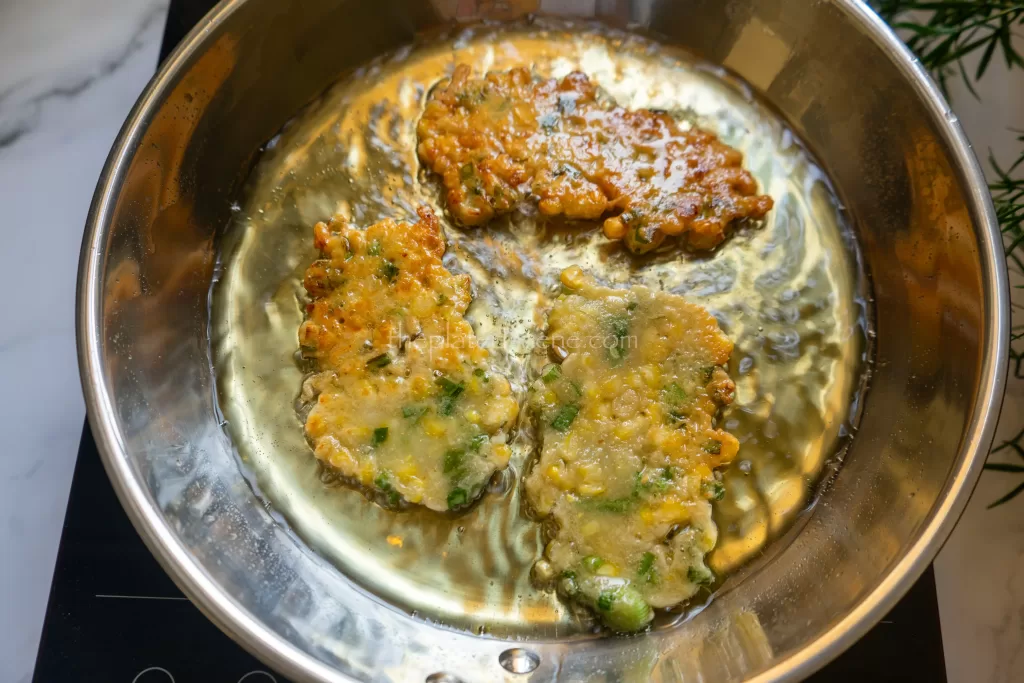
5. Drain Excess Oil
Once the bakwan jagung is golden brown and crispy, please remove it from the pan and place it on a drying rack or a plate lined with paper towels. This step helps drain excess oil, keeping the fritters crisp and light.
Pro Tip: Avoid stacking the fritters while hot, as this can trap steam and make them soggy. Let them cool slightly in a single layer before serving.
6. Serve and Enjoy
Serve the freshly fried bakwan jagung warm. Pair them with your favorite dipping sauce, like sambal, or enjoy them as a standalone snack or side dish. These crispy, savory-sweet fritters will surely be a hit, whether for a family gathering, teatime treat, or simple comfort food at home!
Pro Tip: Place leftover fritters in a preheated oven or air fryer at 180°C (350°F) for a few minutes to reheat leftover fritters. This will restore their crispiness without making them oily.
Storing Instructions for Bakwan Jagung
If you have leftover bakwan jagung or want to prepare them in advance, follow these storage tips to maintain their quality and enjoy them later:
- Cool Before Storing
Allow the bakwan jagung to cool completely before storing them. Storing warm fritters can cause condensation, leading to sogginess. - Refrigeration (Short-Term Storage)
- Place the cooled bakwan jagung in an airtight container or wrap them tightly in aluminum foil.
- Store in the refrigerator for up to 2–3 days.
- To reheat, use an oven, toaster oven, or air fryer at 180°C (350°F) for a few minutes until crispy. Avoid using a microwave, as it may make the fritters soft.
- Freezing (Long-Term Storage)
- Arrange the cooled fritters in a single layer on a baking sheet or plate.
- Place the sheet in the freezer for 1–2 hours to flash-freeze the fritters. This prevents them from sticking together.
- Once frozen, transfer the fritters to a ziplock bag or airtight container.
- Label the container with the date and store it in the freezer for up to 1 month.
- Reheating Frozen Fritters:
- Preheat your oven or air fryer to 180°C (350°F).
- Place the frozen fritters directly in the oven or air fryer (no need to thaw) and heat for 8–10 minutes or until crispy and heated.
- Storing Batter
- If you have leftover batter, you can store it separately. Transfer the batter to an airtight container and refrigerate for up to 1 day.
- Before frying, stir the batter gently to ensure even consistency. If it thickens, add a small amount of water or coconut milk to adjust.
- Pro Tip for Maintaining Crispiness
- Always reheat bakwan jagung in a dry heat environment (oven or air fryer) to restore their crispiness. Avoid reheating them on a stovetop or microwave without a crisping tray, as these methods can make the fritters soggy.
Following these storage and reheating tips, you can enjoy your bakwan jagung at its best, even days or weeks after preparing it!
